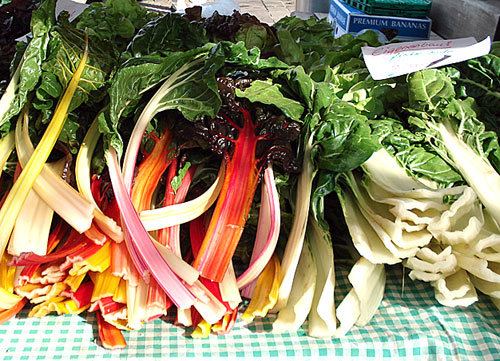Produce: Swiss chard

With the recent spinach-e.coli scare in the U.S., a lot of attention is being paid to alternative greens. Frankly I think this is a bit silly, since it's not like the conditions that could have possibly caused the e.coli bacteria to contaminate the spinach crops, such as improper handling or fertilising with infected manure, would just target Popeye's favorite food to the exclusion of other green leafy vegetables. However the good thing is that it does give an excuse to try other kinds of greens and experiment a bit.
Due to its bright dark green leaves and relatively bland flavor, Swiss chard is being touted as a spinach alternative. It's not exactly like spinach, since the leaves are much thicker, as are the stalks. To me, the stalks are a lot tastier than the leaves, though the leaves have more nutritional value. I always separate them anyway since they have different cooking times. Also, while the bright stemmed ones are pretty, the classic white stemmed ones have much better flavor. Those thick, white stems are very juicy and sort of like less fibrous versions of celery stalks, with a much more subtle flavor. The stems of the brightly colored ones are thin and can be rather tough sometimes. The bright stemmed ones are nice when the leaves are picked very young and put into a salad though. Mature chard leaves are better when cooked, in my opinion.
Swiss chard is actually a variety of the beet plant bred for more leaf production, so you can use it in any recipes that call for beet greens.
The picture above shows an array of Swiss chard being sold at a local market. Incidentally, here in Switzerland it is not called Swiss anything. In the German speaking parts it's usually called either Krautstiele, Stielmangold or plain Mangold, and in the French speaking parts it's just called blette. Apparently it was called Swiss chard in some English-language seed catalogs to differentiate it from French charde or chardon originally. It is very popular here in any case, and grows like crazy in this cool yet mild climate.
There's a traditional dish from the eastern part of Switzerland called the Grisons (the area where the story of Heidi was set) called capuns. Swiss chard leaves are stuffed with a rich mixture of cheese and grains, and cooked in milk or soup stock. I prefer this vegetable a lot plainer though, so here are two very quick and easy ways to enjoy Swiss chard.
Braised Swiss chard stems
Cut off the stems from about 4-5 large white-stemmed Swiss chard leaves. Reserve the leaves for another dish. Wash well and cut off any discolored parts. Cut into chunks about 1.5cm / 1/2 inch wide.
Heat up a pan with a little butter or olive oil. Toss in the stems, and toss. Cover the pan and cook over medium-low heat, stirring several times, for about 25 minutes until it's turning golden-brown around the outside and translucent.
Take off the lid and turn up the heat, and toss briefly to evaporate any remaining water. Season with salt and pepper.
Stir fried Swiss chard leaves
- Green parts of 4-5 Swiss chard leaves
- 2 garlic cloves
- 1 chili pepper
- 1 Tbs. Soy sauce
- Oil for stir fry (such as peanut oil)
- 1 tsp sesame seed oil
- Salt and pepper
Chop up the garlic and the red pepper. (You can de-seed the pepper if you want, though I don't bother to.) Roughly chop up the Swiss chard leaves.
Heat up a wok with oil of your choice over high heat, and toss in the garlic and pepper. Toss in the Swiss chard. Stir rapidly until the leaves are wilted. This will only take a couple of minutes.
Put in the soy sauce and sesame oil and stir around rapidly. Season with salt (if needed) and pepper. Serve immediately.
If you enjoyed this article, please consider becoming my patron via Patreon. ^_^

 Welcome to Just Hungry, where we serve authentic Japanese recipes and more! I'm
Welcome to Just Hungry, where we serve authentic Japanese recipes and more! I'm 












